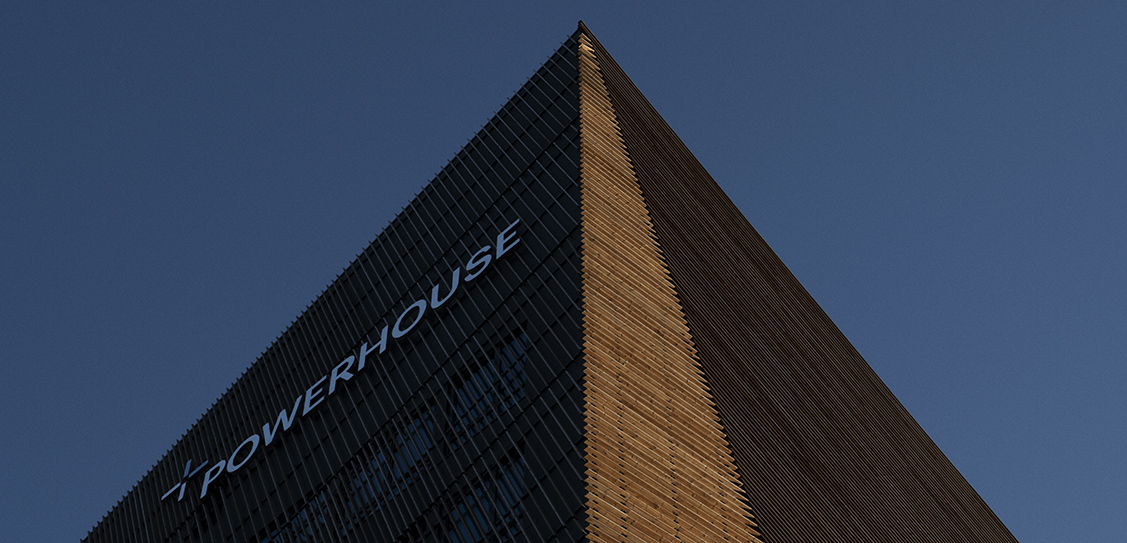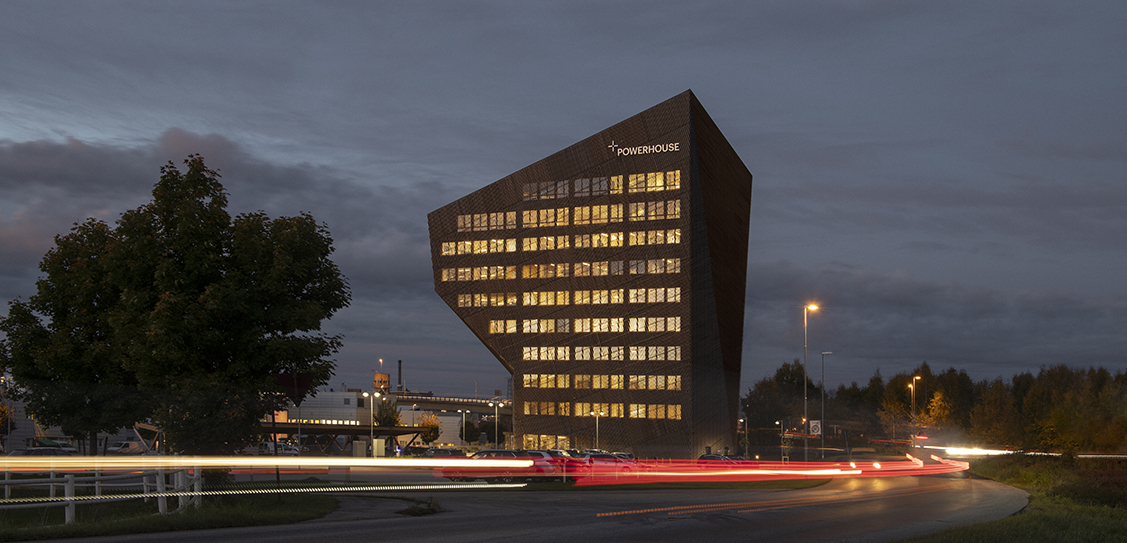As part of the Powerhouse series, Powerhouse Telemark sets a new standard for the construction of environmentally sustainable buildings by reducing its yearly net energy consumption by 70% compared to similar new-construction offices, and by producing more energy than it will consume over its entire lifespan.
Through standardised interior solutions and co-working spaces, tenants can scale their office spaces as needed, granting much needed flexibility in a global context where remote working solutions continue to increase in demand.
Situated in the historic industrial city of Porsgrunn in the county of Vestfold and Telemark, the new 11 storey building marks a symbolic continuation of the district’s proud history as Telemark is home to one of the early 19th Century’s largest hydropower plants. Powerhouse Telemark indicates the area’s growing investment in the green economy, positioning the county as a leader in decarbonising new construction.
The south-east facing façade and roof of Powerhouse Telemark will generate 256,000 kWh each year, approximately twenty times the annual energy use of an average Norwegian household, and surplus energy will be sold back to the energy grid.
The skewed and slightly conical building features a clearly defined 45° tilting notch on the east-facing façade, giving it a clearly identifiable expression that stands out in the industrial context of the surrounding Herøya industry park. Inside, the building features a barception, office space, including two stories of co-working spaces, a shared staff restaurant, penthouse meeting spaces and a roof terrace overlooking the fjord. Two large staircases connect the building’s ground and top floors, from the reception area and all the way up to the staff restaurant and penthouse meeting rooms. A distinctive straight wooden staircase reveals itself at the ninth floor, visually tying the staff canteen and penthouse meeting room area together and leading visitors to the building’s roof terrace.
The building has been awarded the BREEAM Excellent certification and its 24° tilted roof gently slopes to surpass the extremities of the building’s volume, expanding the roof’s surface and ensuring a maximum amount of solar energy can be harvested both from the photovoltaic canopy and the building’s PV-cell clad south-facing façade.
To the west, north-west and north-east the building is clad with wooden balusters providing natural shading on the most sun exposed façade. Behind the wooden balusters the building is covered with Steni façade panels which give the building a unified expression. Functioning just as a passive house, the building is super insulated and features triple isolated windows throughout. The concrete slabs lend the building a density akin to that of a stone structure storing thermal heat during the day and slowly emitting heat during the evening. A low ex system with water loops in the border zones of each floor, assures that the building is efficiently cooled and heated through geothermal wells dug 350 m below ground.
The building’s gently skewed West-facing and South-East-facing facades allow for a maximum of daylight and shading while also generating views and flexible indoor spaces. To the North-East the building is leveled to accommodate for more traditional workspaces with enclosed offices. Throughout the building, small, secluded spaces are strategically moved away from sun exposed facades to reduce the need for cooling while also assuring that these spaces keep a comfortable temperature.
The interior design of the building is built upon a principle of standardisation to reduce unnecessary waste as new tenants move into the building. The flooring, glass walls, office dividers, kitchenettes, lighting, and bathrooms have been given the same design, colour, and materiality across all floors. Indeed, the flexibility of the interior solution of the building, combined with the building’s two story coworking space, allows for the client and future tenants to easily re-programme the building and expand or downsize their businesses without needing to relocate.
The material palette of Powerhouse Telemark is chosen for its environmentally sustainable qualities. Throughout, the building features sturdy materials known for resilience and low-embodied energy. This means using materials such as local wood, gypsum and environmental concrete which is left exposed and untreated. Everything from the kitchens to the carpet tiles and loose furniture are made from durable and high-quality materials. The carpet tiles are composed of 70% recycled fishing nets and the wooden flooring is made from industrial parquet of ash from wooden debris.
A foliating signage system allows for a certain amount of flexibility in tailoring the visual expression of the different office spaces without creating unnecessary waste that may be generated when brand specific signage is removed or produced.
To reduce the need for artificial lighting to an absolute minimum, the building has a conservative but efficient lighting system. The building’s roof also features vertical glass slots, allowing for daylight penetration on the three top floors.



